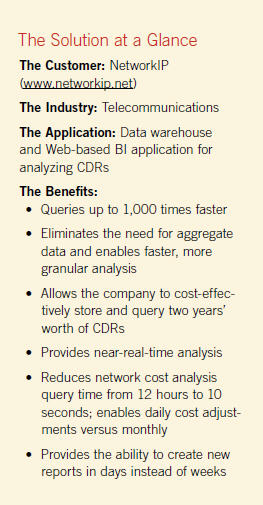CASE STUDY - NetworkIP Dials Up Blazingly Fast Call Detail Analysis
By Stephan Broquie, Director of Business Application Development, NetworkIP

Founded in 1998, NetworkIP is the innovator and leader in providing prepaid services to the telecommunications industry. NetworkIP provides a carrier-grade platform, as well as products and services that enable its customers to offer telephone calling cards, audio conferencing, and other prepaid services on a turn-key basis. The company’s customers include major carriers, telecom service providers, distributors, resellers, CLECs, ILECs, ISPs, and publishers.
Customers rely heavily on access to the data in NetworkIP’s call detail records (CDRs) to make business decisions such as calling program rate changes. NetworkIP answers this need with its award-winning Integrated Connection Solution (ICS) platform. Using the ICS application, customers can mine the CDRs to analyze their traffic patterns, monitor and forecast their profitability, and perform other analyses.
Customers loved the application. But as NetworkIP’s business evolved, its customers became savvier and more data-hungry. They started requesting reports that Stephan Broquie, director of business application development, couldn’t easily support with the summary tables he and his team had built. In short, the ICS had become a victim of its own success.
Broquie explained: “Our customers’ focus used to be mostly on what happened last week and last month. Today, customers want to know things over a long period of time. They want to look at trends and at things that happened over the last 12 months, and to be able to compare this year with last year. Most of our queries have only been able to accommodate a date range of 90 days. And, within a 90-day date range, the system will provide a response within a minute or so. This clearly wasn’t good enough.”
Customer demands were outpacing the application. Broquie and his team needed to provide a solution that would let customers query the raw CDRs for any period of time. It would have to store at least two years’ worth of CDRs—about 1.2 billion records, each containing approximately 200 pieces of information—and deliver responses in 10 seconds or fewer for 90 percent of queries.
NetworkIP selected the Vertica Analytic Database, a high-performance, column-oriented RDBMS that runs on industry-standard, Linux-based hardware. Because of its speed, the Vertica database lets NetworkIP avoid working with summary or aggregate data, which improves accuracy, reduces DBA time, and allows NetworkIP and its customers to do more granular analysis.
“Vertica gives us near-real-time access to data,” said Broquie. “ICS Reports include data that may be only 30 minutes old—instead of a day old. Formerly, I couldn’t provide our customers any information for today until tomorrow, because our summarization process took place at night in batch. Vertica’s trickle loading capability enables data to flow into the system on a 24/7 basis so customers can quickly evaluate the effects of calling plan changes and readjust them accordingly—cycles which can now happen several times per day.”
The company is also seeing big performance advantages with internal use. For example, it has cut the time to perform a critical monthly cost analysis of toll-free traffic from 12 hours (using MySQL and summary tables) to 10 seconds (using Vertica). NetworkIP also analyzes call data in near real time, making routing decisions based on complex tradeoffs to deliver the best customer experience at the lowest cost.
“We spent most of last year creating a new data mining center with a reporting engine that is very flexible and allows us to create new reports very quickly,” Broquie explained. “What I didn’t have until now was a database engine that could support this type of flexible reporting.”
Vertica will also save money for NetworkIP in hardware and administration over the long term. NetworkIP is running on a four-node cluster of Dell 2950 servers. Each server has two quad-core CPUs with 16 GB of RAM and 1.2 TB of storage across four hard drives. To scale database performance and storage, Broquie and his team can just add inexpensive, off-the-shelf servers.
“The bottom line is that Vertica is solving problems. It is solving our current problems and it will allow us to launch a new generation of applications that will help our business grow,” concluded Broquie.
For a free white paper on this topic, click here and choose the title “Optimizing DBMS Architectures for Next-Generation Data Warehousing.”